Key Insights
- Network usage, measured by smart contract calls and transactions, saw YoY growth despite the bear market.
- Tezos ended the fourth quarter with an all-time high in TVL (XTZ).
- During 2022, Tezos NFT sales (XTZ) were up 115% YoY.
- Tezos has successfully completed four forkless upgrades this year, with the most recent, Lima, launching on mainnet in December.
- Tezos’s 13th protocol upgrade, Mumbai, is scheduled to go live on mainnet in the first half of 2023. Mumbai will be a major upgrade as it introduces three key innovations: Smart Contract Optimistic Rollups, Validity Rollups on testnet, and shortened block times.
Primer on Tezos
Tezos is a Liquid Proof-of-Stake (LPoS) blockchain network that relies on low power consumption and energy-efficient consensus. It combines on-chain governance with self-amending functionality to implement forkless network upgrades and manage future changes. Tezos supports multiple smart contract languages, has a robust NFT ecosystem, and continues to scale through EVM- and WASM-compatible rollups and data availability layer improvements.
Key Metrics
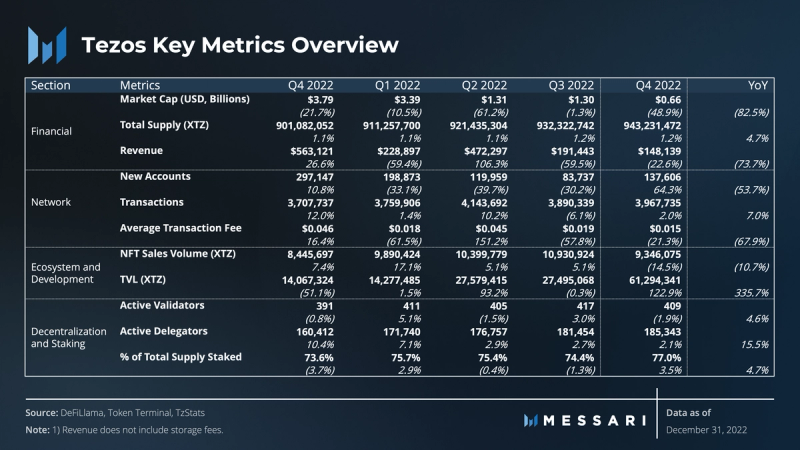
Performance Analysis
Financial Overview
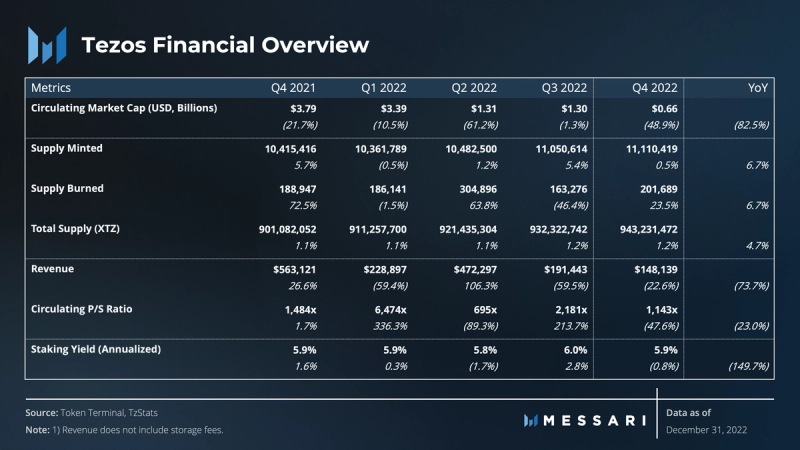
After a relatively peaceful third quarter by 2022 standards, the fourth quarter saw another massive negative event with the collapse of FTX. Tezos was not immune to the effects and lost 49% of its market capitalization, falling from $1.3 billion to $663 million.
XTZ token metrics remained steady. The total supply of XTZ increased by 1% from the previous quarter, bringing the total supply to 943 million XTZ at the end of 2022. Revenue also decreased by 23% from the previous quarter to $148,000, driven by a 21% drop in transaction fees.
While evaluating these metrics, it’s important to keep in mind that native blockchain assets are a new asset class that requires different valuation methods. As a result, traditional financial metrics like revenue and price-to-sales ratios may not be the most relevant.
Network Overview
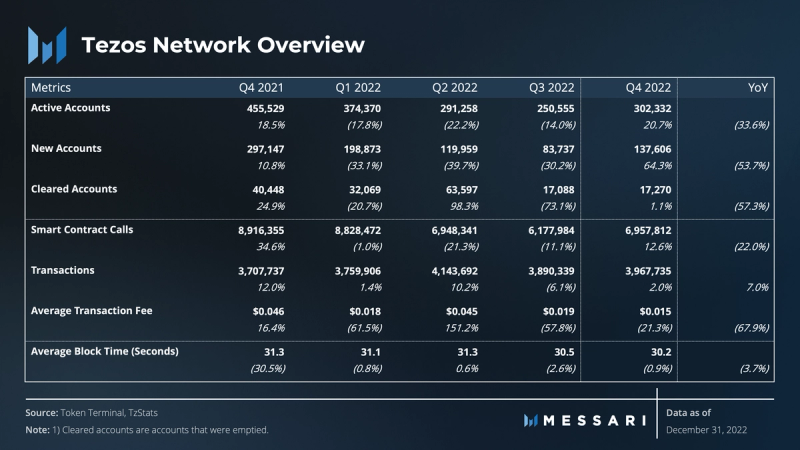
Account Activity
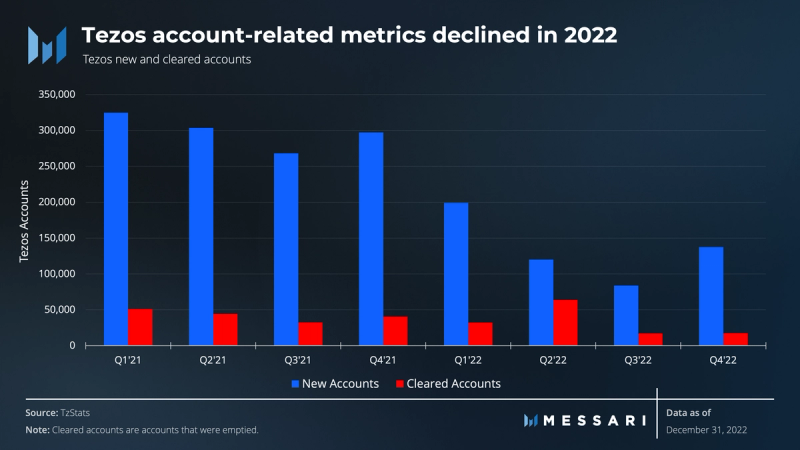
Following a slow third quarter, Tezos account-related metrics rebounded in the fourth quarter. New accounts increased 64% QoQ to 140,000, cleared accounts were flat, and active accounts jumped 21% QoQ to 300,000. The positive developments were fairly distributed across the NFT, gaming, and DeFi sectors (more on this in the Ecosystem and Development section).
Overall, Tezos’s account-related metrics declined in 2022. The number of new accounts decreased by 55% from 1.2 million in 2021 to 540,000 in 2022, and active accounts fell 24% from 1.6 million to 1.2 million during the same period. Cleared accounts, i.e., accounts that were emptied, also decreased by 23% from 168,000 to 130,000, which is actually a good thing because it means fewer users are leaving the ecosystem. The drop in account metrics shows a decrease in user sentiment following the 2021 bull market and the current bear market in 2022.
There are a few points to consider when analyzing the creation of new accounts on Tezos. Firstly, all new accounts on Tezos have to pay a small one-time fee, usually around $0.25. This fee discourages people from spamming the network with multiple new accounts. Additionally, if someone gets an asset on Tezos, like an NFT, without creating an account, they will not be included in this data. These are important things to keep in mind when evaluating account activity across different ecosystems.
Network Usage
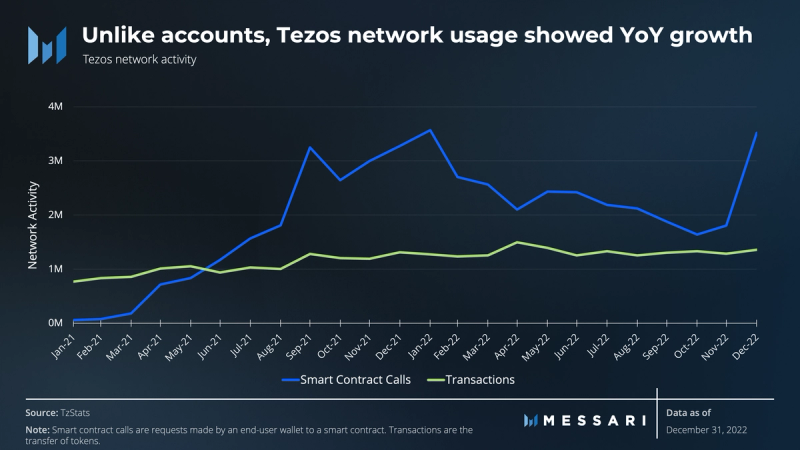
Network usage is measured by the number of smart contract calls and transactions. Smart contract calls are requests sent by a user’s wallet to a smart contract, while transactions refer to the movement of tokens. In the fourth quarter, network usage saw a significant increase, mainly driven by an uptick in smart contract calls, which can be attributed to the minting of Manchester United NFTs.
Network usage also experienced growth on a YoY basis. The number of smart contract calls increased by 56% from 19 million in 2021 to 29 million in 2022, and the number of transactions grew by 26% from 12 million in 2021 to 16 million in 2022. The increase in network activity combined with the decrease in users suggests that the remaining active users are highly active.
The upcoming release of Smart Contract Optimistic Rollups (SCORUs) in the Mumbai upgrade is expected to boost activity. SCORUs will greatly enhance the network’s capabilities by increasing throughput and supporting new execution environments (more information on this can be found in the Mumbai subsection in the Strategy and Outlook section). The first planned execution environment for SCORUs is WebAssembly (WASM).
Ecosystem and Development Overview
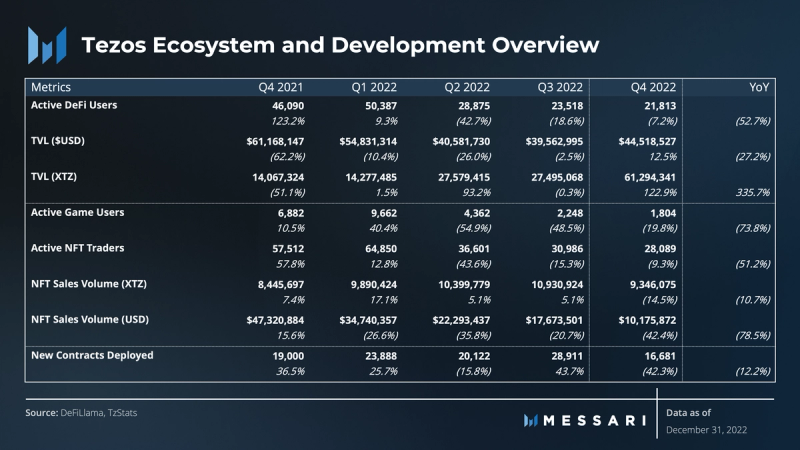
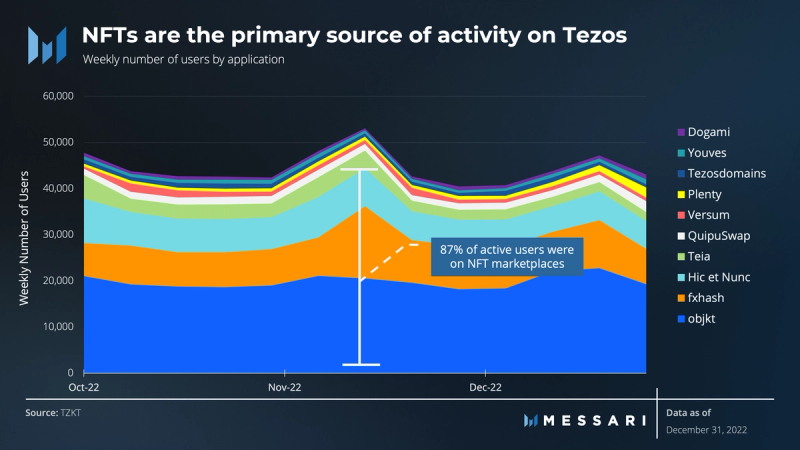
NFTs are still the main source of activity on Tezos, so NFT marketplaces continue to be the most popular applications. During the fourth quarter, NFT marketplaces had the top four applications by active users, with about 10,000 weekly active users (87% of all active users on the network). Objkt had the most users, followed by fxhash, Hic et Nunc, and Teia. DeFi protocols had the second most active users, followed by gaming. However, active users decreased in all three sectors for the third quarter in a row. Despite the drop in user metrics, some areas, especially DeFi, showed promise.
NFTs
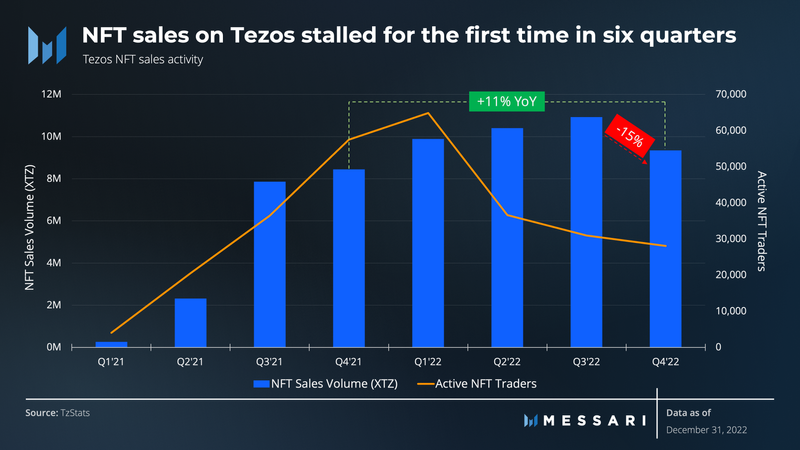
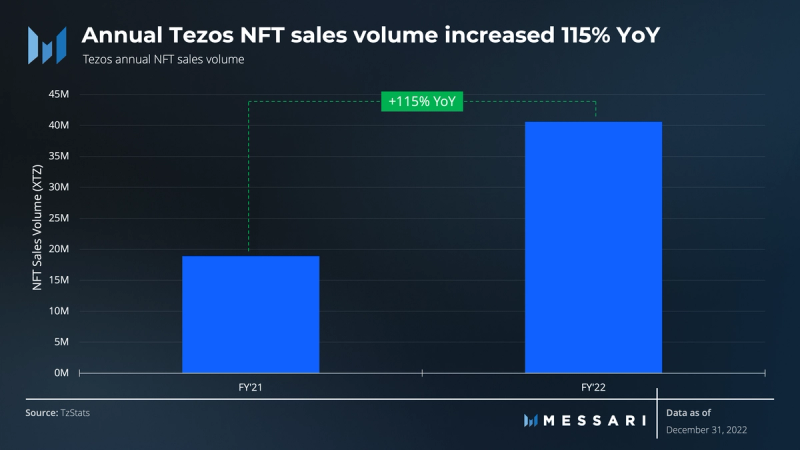
After increasing for six consecutive quarters and setting an all-time high in Q3, NFT sales volume (XTZ) stalled during Q4. Overall, NFT sales fell 15% QoQ from 10.9 million XTZ to 9.3 million XTZ. The marginal decline is likely attributable to the FTX collapse distracting users and the inevitable slowdown after nearly two years of up only.
Despite the near-term decline, multiple noteworthy NFT-related events occurred:
- Manchester United NFTs were minted. The NFTs can be traded on the secondary market at objkt.
- A plugin for WordPress, called MinterPress, was introduced. It allows users to easily mint and display NFTs powered by Tezos.
- Renowned musician Ziggy Marley conducted an NFT drop with OneOf.
- The fractionalized NFT platform sliced.art was announced.
On an annual basis, NFT sales are up significantly. During 2022, there were 41 million Tezos NFT sales (XTZ), up 115% YoY from 19 million in 2021. The increase in sales during arguably the worst year in crypto history underscores the excitement surrounding the Tezos NFT ecosystem.
Of note, Tezos faces vigorous competition from other base layers in the NFT sector. During Q4, Ethereum registered 1.3 million unique NFT buyers, Solana 600,000 unique buyers, and Polygon 200,000 unique buyers, compared to 28,000 active traders on Tezos.
Gaming
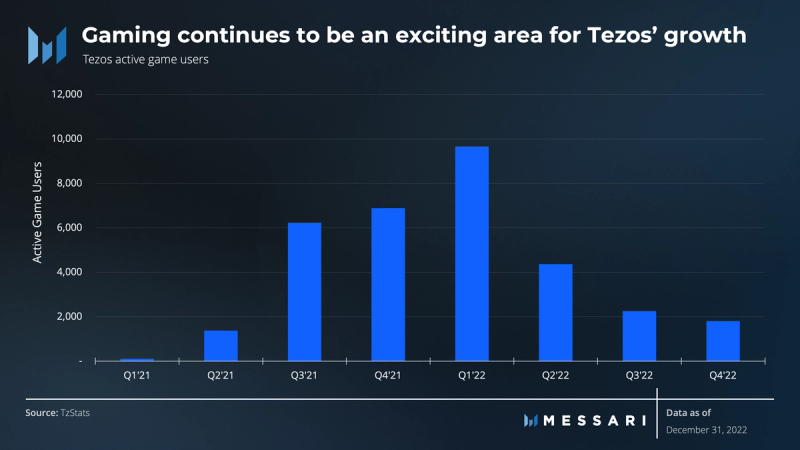
Despite being the smallest component of the ecosystem, Tezos gaming continues to be an exciting area for growth. During 2022, Tezos averaged 4,500 active game users per quarter, up 24% YoY from 3,600 in 2021. Notable live games include:
- Tezotopia – A real-time NFT-strategy game where players can act as landlords, battle other players (PVP), and compete in tournaments for prizes.
- Circuit Breaker (Sutuverse) – Users sprint through a neon maze of obstacles, corridors, and moving platforms to secure the fastest time. Circuit breaker is a game within the Sutuverse, a Web3 gaming metaverse housing NFTs, games, etc.
- Pixel Potus – A digital collectible game where users can trade, buy, and sell cards of the U.S. presidents.
- Emergents – A comic-book-themed strategy trading card game.
- Blockxer – An arcade-style game where users choose a hero and battle various enemies while walking down a street with the goal of setting a new high score.
- ChainBorn – A PVP hero battle game.
- Bunny Knights – A game based on 2,500 medieval-themed bunny NFTs that are used as warriors and can be used for battles.
Additionally, multiple games with live demos are in development including Pigs at War, Dogami, Matterlight, and Knights of Tezonia. Of note, Dogami was one of the more highly anticipated games, securing $14 million in funding.
Tezos also has partnerships with prominent companies Unity and Ubisoft. The Unity partnership will create a Web3 software development kit (SDK) as an optional plug-in via the Unity Asset Store for Web3 game development. The Ubisoft partnership introduced UbisoftQuartz, a platform for players to get their first NFTs for its Ghost Recon Breakpoint game.
DeFi
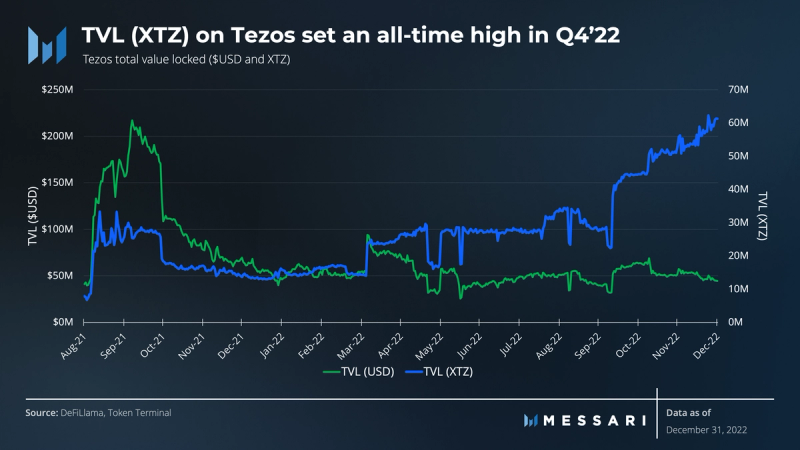
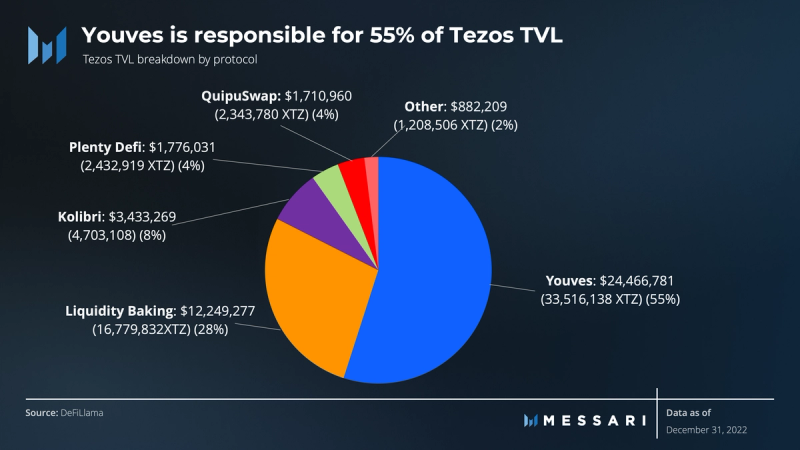
At the end of the fourth quarter, Tezos reached an all-time high of 61 million in total value locked (TVL) in XTZ, representing a 336% increase from the previous year. In USD, Tezos had a TVL of $45 million at the end of Q4, a 13% increase from Q3. The smaller increase in USD TVL compared to XTZ TVL was due to a 49% decrease in the price of XTZ in Q4.
Youves, a synthetic asset protocol, was largely responsible for the TVL increase. Youves experienced a spike in activity following a partnership with Ubinetic to help onboard financial institutions with DeFi and developing conversations with market makers to further increase Tezos’ DeFi liquidity.
Overall, Tezos DeFi TVL ranks approximately 40th amongst base layer protocols. New protocols scheduled to launch include Mavryk Finance and Zenith, which should lead to further increases in activity and TVL; however, Tezos TVL remains considerably off the leading ecosystems.
Development Activity
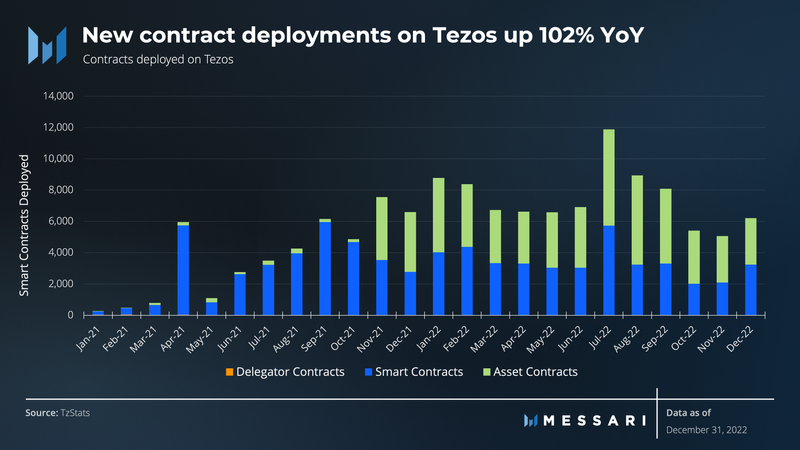
Tezos was included in the top developer ecosystems, as shown in the 2021 annual Electric Capital Developer Report. Even during the bear market of 2022, Tezos saw a 102% increase in developer activity (as measured by contract deployments) compared to the previous year.
In its upcoming Mumbai upgrade, Tezos will add Smart Contract Optimistic Rollups (SCORUs), which will go beyond the current Michelson Virtual Machine to support WebAssembly (WASM) and the Ethereum Virtual Machine (EVM). By supporting these new environments, Tezos will be able to use popular programming languages like C++, Rust, and Solidity. These new environments and languages should boost development and encourage the migration of applications from other networks to Tezos.
Decentralization and Staking Overview
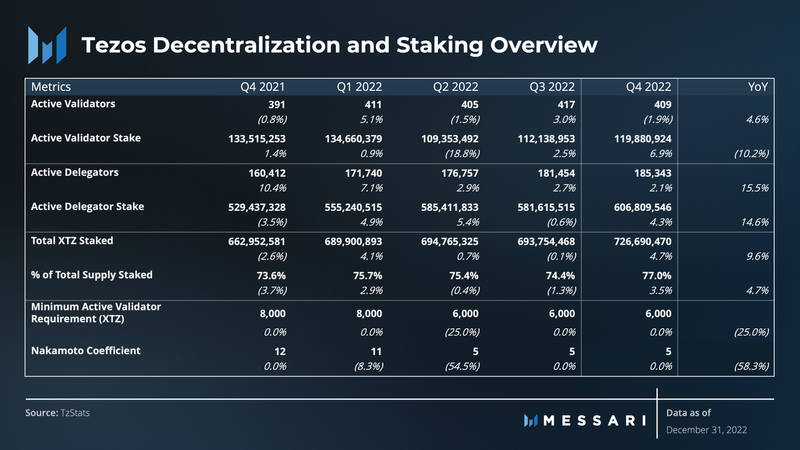
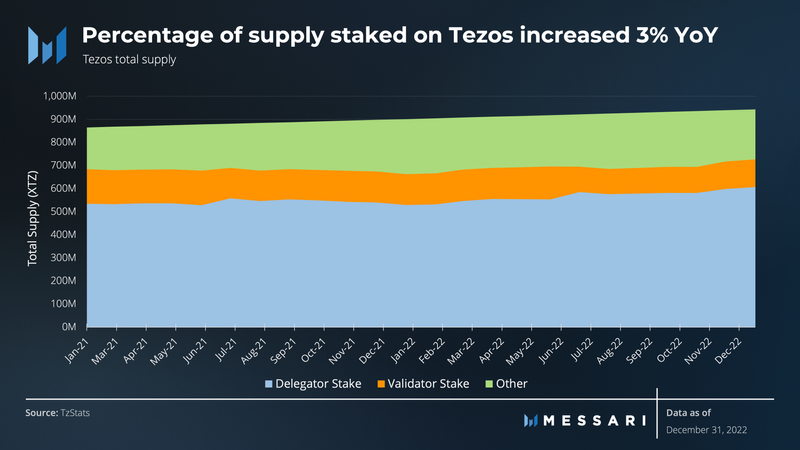
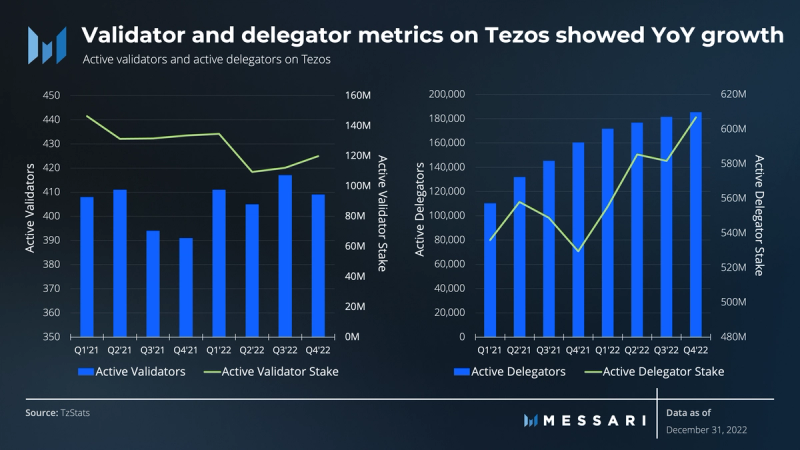
Tezos uses a Liquid Proof-of-Stake (LPoS) mechanism. Unlike the more common Delegated Proof-of-Stake (DPoS) consensus, LPoS allows delegators to participate in consensus while maintaining custody of their tokens. As a result, the delegated stake is completely liquid. The Tezos network benefits from having a large percentage of staked tokens liquid because the liquid tokens can be reused.
During the fourth quarter and throughout 2022, Tezos’ decentralization and staking metrics remained stable, indicating a healthy and functioning network. At the end of 2022, 77% of the total supply was staked, up from 74% in 2021. The number of validators, also known as bakers, increased by 5% YoY from 391 to 409.
The Ithaca upgrade in April may have contributed to the increase in validators. It reduced the minimum amount of XTZ required to be a validator from 8,000 XTZ to 6,000 XTZ. The upgrade also increased rewards and improved overall functionality.
The number of delegators increased by 16% from 160,000 in 2021 to 185,000 in 2022. Delegators make up 84% of the total stake.
Qualitative Analysis
Strategy and Outlook
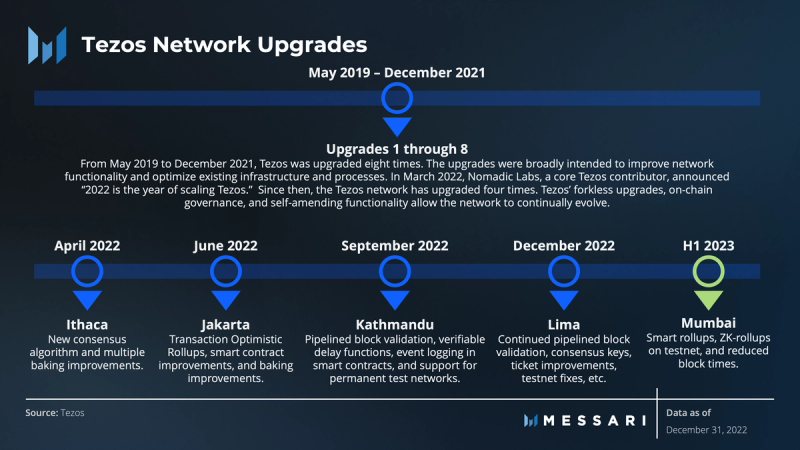
Tezos is a self-amending blockchain that removes the need to hard fork by employing on-chain governance for protocol upgrades. With the Lima upgrade recently launching on mainnet, the Tezos Network has forklessly upgraded four times this year. For a more detailed review of the previous upgrades, check out the previous Tezos quarterly reports.
The successful upgrades substantiated Nomadic Labs proclamation that “2022 is the year of scaling Tezos.” At TezDev Paris in July, Tezos core contributors doubled down on their scaling commitment with an updated goal of “one million transactions per second.” They plan on making significant progress on that target with the launch of smart rollups in the upcoming Mumbai upgrade.
Lima Upgrade
On December 19, the 12th protocol upgrade Lima went live. Its main features include:
- More pipelining – Continued separation of validation from the application of operations and blocks. Lima builds on Kathmandu by extending pipelined validation to all remaining classes of operations and to blocks themselves. Having more pipelines results in increased network throughput.
- Consensus keys – With consensus keys, bakers can change their key for signing blocks and consensus operations without changing their public address. As a result, delegators will no longer need to actively redelegate to a new address.
- Ticket improvements – Zero amount tickets are deprecated, thus removing a source of inconvenience and reducing smart contract bug risk. Ticket ownership updates are added to transaction receipts helping indexers keep track of tickets.
- Ghostnet fixes – Lima fixes two technical problems that arose during the migration from Jakarta to Kathmandu: VDF-feature misalignments and voting period bugs.
- Liquidity baking sunset removed – The liquidity baking sunset was removed because the subsidy can be shut off with the moving-average toggle introduced in Jakarta.
- Temporary timelock deprecation – Due to a discovered vulnerability, the origination of new contracts using Timelock will be disabled until a safer mechanism is developed.
Mumbai Upgrade

Tezos’ 13th protocol upgrade Mumbai is expected to launch on mainnet in H1 2023. Mumbai will introduce three major innovations:
- Smart rollup activation – Smart rollups are enshrined optimistic rollups extending beyond Michelson to support new environments including WASM and EVM. They enable developers to implement their application(s) as a rollup, effectively making the smart rollup an application-specific rollup. Smart rollups are being rigorously tested on testnet and will first launch with support for WASM.
- Validity rollups on testnet – Validity rollups (commonly referred to as ZK-rollups) will begin testing on testnet. The current implementation of the ZK-rollups is named Epoxy, and it will be gradually rolled out over multiple upgrades.
- Reduced block times – Beginning with Kathmandu, core developers set out to optimize and streamline the internal validation process. Mumbai brings the final installment of the validation optimization venture by separating the validation from the application of blocks and operations. This allows blocks and operations to be propagated faster, which will cut blocktimes to 15-30 seconds.
Roadmap
Looking forward, Tezos core developers have a number of meaningful assignments:
- The launch of smart rollups on mainnet will require extensive monitoring, testing, and optimizing. Tezos is actively encouraging developers to begin working with smart rollups on testnet to streamline the rollout.
- The development of data availability solutions will be critical to avoiding state bloat. Core developers are currently preparing two solutions: 1) an off-chain data availability mechanism that relies on centralized data providers (this is an interim solution) and 2) a public-good rollup data availability layer which is expected to greatly increase throughput.
- The introduction of ZK-rollups in project Epoxy. Similar to smart rollups, ZK-rollups will begin on testnet and undergo significant testing. ZK technology is expected to be one of the leading themes in crypto in 2023.
Closing Summary
2022 was a historic year in the crypto industry. Multiple major events lead to a 65% decline in total market value. Tezos was not spared, ending the year with a circulating market cap of $663 million, an 83% decrease YoY. Despite these challenges, some positive developments presented themselves.
The Tezos DeFi ecosystem grew in 2022, with the TVL (XTZ) increasing 336% YoY from 14 million to 61 million. While Tezos DeFi still lags behind leading base layer protocols, the emergence of promising projects like Youves has the potential to drive future growth. Additionally, multiple highly-anticipated projects are currently in development.
The Tezos NFT ecosystem remained a leader in the space in 2022. During Q3, NFT sales volume (XTZ) reached an all-time high, and overall NFT volume remained steady. However, it should be noted that there was a 50% decrease in NFT traders YoY, which indicates that the current active members of the NFT community are dedicated and loyal.
Additionally, Tezos continued to evolve as it forklessly upgraded four times this year. The self-amending functionality and forkless upgrades allowed Tezos to introduce a new consensus mechanism, transaction optimistic rollups, pipelined block validation, validator improvements, and a plethora of additional functionality without skipping a beat. In fact, Tezos core developers doubled down on their scaling ambitions with the forthcoming release of smart contract optimistic rollups and a goal of one million TPS.
Ultimately, the protocols that continued to develop and progress during the bear market are well-positioned to benefit when the market turns bullish. Tezos maintained its development trajectory and in some cases, even saw increased levels of activity, positioning it well for a strong performance in 2023.
















